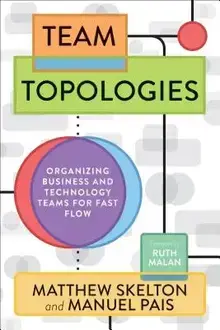Team Dynamics
The patterns of interaction, behavior, and influence between members of a team. Team dynamics shape how work is done, how decisions are made, and how conflict or collaboration unfold over time. Healthy dynamics foster trust, psychological safety, and effective coordination --- while toxic dynamics can lead to misalignment, disengagement, or performance breakdowns.
Below is an overview of content that matches the tag "team dynamics".
Note that this list is not exhaustive, as it is automatically aggregated based on manually assigned categorizations.
If you notice a missing element, or think some of the items are wrongfully categorized, please create a bug/improvement ticket on our github issue tracker.
Books tagged with "Team Dynamics"
Apprenticeship Patterns
Guidance for the Aspiring Software Craftsman
Hoover, D.; Oshineye, A. (2009) Apprenticeship Patterns. O'Reilly Media, Inc.. isbn: 978-0596518387.
Perfect for developers moving into new teams or roles, Apprenticeship Patterns offers practical guidance on integrating quickly and contributing meaningfully. The authors package each lesson as a named pattern, complete with suggested actions and reflection prompts. One memorable example, “Sweep the Floor,” encourages craftspeople to tackle humble work early so they can earn trust and accelerate their learning.
Nonviolent Communication
A Language of Life
Rosenberg, M. B. (2015) Nonviolent Communication. PuddleDancer Press. isbn: 978-1892005281.
Nonviolent Communication teaches empathic dialogue that surfaces needs without judgement or blame. Rosenberg encourages beginning with compassionate self-talk, then expressing observations, feelings, needs, and requests clearly. The sentence structures may feel formal at first, yet with practice the approach becomes a practical way to build understanding in everyday conversations.
Behind Closed Doors
Secrets of Great Management
Rothman, J.; Derby, E. (2005) Behind Closed Doors. The Pragmatic Bookshelf. isbn: 978-0976694021.
Behind Closed Doors follows interim manager Sam as he steadies a struggling team and rebuilds trust. Johanna Rothman and Esther Derby show how purposeful one-on-ones, visual management, and timely feedback change the team’s trajectory. The narrative makes core management habits accessible and easy to adapt to your own context.
The Five Dysfunctions of a Team
A Leadership Fable
Lencioni, P. (2009) The Five Dysfunctions of a Team. Winsome Book India. isbn: 978-8126522743.
The Five Dysfunctions of a Team explores how trust, conflict, commitment, accountability, and results form a tightly coupled system. Patrick Lencioni tells a leadership fable about an executive team that slips into dysfunction, then demonstrates facilitation techniques to reverse the spiral. It is a quick read for leaders and team members who want to spot warning signs early and restore performance.
Extreme Programming Explained
Embrace Change
Beck, K.; Andres, C. (2004) Extreme Programming Explained. Addison-Wesley. isbn: 978-0321278654.
Extreme Programming Explained centres on daily engineering practices—pairing, test-driven development, continuous integration—that keep teams adaptable. Kent Beck and Cynthia Andres advocate short feedback loops, shared ownership, and sustainable pace instead of rigid process prescription. It remains a key reference for developers who want to ground agile values in concrete software practices.
Ryan, T. (2019) Driving Technical Change. The Pragmatic Bookshelf. isbn: 978-1934356609.
Driving Technical Change tackles the challenge technologists face when they see a better way forward but cannot get others onboard. Terrence Ryan profiles common resistance personas and shows how to package experiments, evidence, and storytelling for each audience. The guidance equips experienced developers to become thoughtful change agents who elevate their teams and organisations.
Team Topologies
Organizing Business and Technology Teams for Fast Flow
Skelton, M.; Pais, M. (2019) Team Topologies. It Revolution Press. isbn: 9781942788829.
Team Topologies evolves DevOps topology work into a practical playbook for structuring teams and interactions. Matthew Skelton and Manuel Pais describe four fundamental team types and three interaction modes designed to improve flow and reduce cognitive load. Case studies show how intentional boundaries and communication paths accelerate delivery in complex organisations.
Succeeding with Agile
Software Development Using Scrum
Cohn, M. (2010) Succeeding with Agile. Addison-Wesley. isbn: 0321579364.
Mike Cohn offers a pragmatic guide to adopting Scrum beyond the first pilot team, covering organisational change, scaling, and coaching. He outlines how to tailor roles, plan releases, and handle resistance while keeping agile values intact. The book serves as a reference for leaders shepherding sustained agile transformations.
Lessons Learned in Software Testing
A Context-Driven Approach
Kaner, C.; Bach, J.; Pettichord, B. (2001) Lessons Learned in Software Testing. Wiley. isbn: 978-0471081128.
Cem Kaner, James Bach, and Bret Pettichord share context-driven testing lessons gathered from real projects. They show how to tailor strategy to risk, constraints, and team skills instead of following prescriptive processes. The book is a deep reference for testers and coaches who need adaptable heuristics in complex environments.
Dare to Lead
Brave Work. Tough Conversations. Whole Hearts.
Brown, B. (2018) Dare to Lead. Random House. isbn: 978-0399592522.
Brené Brown translates her research on vulnerability and courage into a leadership playbook that centres trust, empathy, and accountability. The book offers practical tools for naming hard topics, building inclusive rituals, and creating the psychological safety required for teams to do meaningful work together.
The Fearless Organization
Creating Psychological Safety in the Workplace for Learning, Innovation, and Growth
Edmondson, A. C. (2018) The Fearless Organization. Wiley. isbn: 978-1119477242.
Amy Edmondson distills decades of research on psychological safety into a guide for leaders who want teams to learn faster and surface difficult truths. Case studies and diagnostics demonstrate how deliberate facilitation, rapid feedback loops, and shared accountability unlock experimentation without fear of blame.
Manage It!
Your Guide to Modern, Pragmatic Project Management
Rothman, J. (2007) Manage It!. Pragmatic Bookshelf. isbn: 978-0978739249.
Manage It! provides pragmatic project-management practices for teams delivering software under pressure. Johanna Rothman blends real-world case studies with lightweight planning tools so you can balance risk, delivery, and learning without adding bureaucracy. It is a handy reference when you need structure that still leaves room for experimentation.
Argyris, C. (1991) Teaching Smart People How to Learn. Harvard Business Review.
Chris Argyris explains why highly skilled professionals often resist feedback and how facilitators can create space for double-loop learning. He shares interventions coaches can use to surface reasoning, challenge defensive routines, and turn setbacks into shared insight. The essay remains essential for leaders guiding experts through change.









